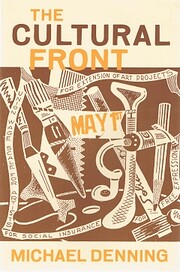

Clique em uma foto para ir ao Google Livros
|
Carregando... The Cultural Front: the Laboring of American Culture in the Twentieth Century (1996)de Michael Denning
 Nenhum(a) Ainda não há conversas na Discussão sobre este livro. sem resenhas | adicionar uma resenha
Pertence à série publicada
As garment workers, longshoremen, autoworkers, sharecroppers and clerks took to the streets, striking and organizing unions in the midst of the Depression, artists, writers and filmmakers joined the insurgent social movement by creating a cultural front. Disney cartoonists walked picket lines, and Billie Holiday sand 'Strange Fruit' at the left-wing cabaret, Cafe Society. Duke Ellington produced a radical musical, "Jump for Joy," New York garment workers staged the legendary Broadway revue "Pins and Needles," and Orson Welles and his Mercury players took their labor operas and anti-fascist Shakespeare to Hollywood and made "Citizen Kane."
A major reassessment of US cultural history, "The Cultural Front" is a vivid mural of this extraordinary upheaval which reshaped American culture in the twentieth century. Não foram encontradas descrições de bibliotecas. |
Current DiscussionsNenhum(a)Capas populares
 Google Books — Carregando... Google Books — Carregando...GênerosClassificação decimal de Dewey (CDD)306.40973Social sciences Social Sciences; Sociology and anthropology Culture and Institutions Specific aspects of culture Biography And History North AmericaClassificação da Biblioteca do Congresso dos E.U.A. (LCC)AvaliaçãoMédia: (3.83) (3.83)
É você?Torne-se um autor do LibraryThing. |
||||||||||||||||||||||||||||||||||||||||||||||||||||||||||||||||||||||||||||||||||||||||||||||||||||||||||||||||||||||||
Denning writes, “By the mid 1930s, the cultural front was sustained by a movement culture, a world of working-class education, recreation, and entertainment built by the Communist Party, the new industrial unions, and the fraternal benefit lodges, particularly those of the International Workers Order (IWO)” (pg. 67). He continues, “It was the peculiar combination of the corporate liberalism of the media corporations, the internal labor relations of the culture industries, and the working-class audience of the film, broadcasting, and music industries that resulted in a remarkable and contradictory politics of mass culture, producing the phenomena of left-wing ‘stars’ and ‘socially conscious’ nightclubs, radio broadcasts, and picture magazines” (pg. 83). Denning further argues, “The aesthetic innovations of the cultural front wrestled with the cultural contradictions of modernity, and led to a laboring of American culture. The characteristic narratives, tropes, and forms of the cultural front – the satiric newsreels, ghetto pastorals, proletarian grotesques, and cabaret blues – informed the most powerful and lasting works of twentieth-century American fiction, music, theater, and film, as well as the cultural criticism and theory that surrounded them” (pg. 118). He adds, “The politics of the Popular Front social movements were rarely populist; rather, the Popular Front combined three distinctive political tendencies: a social democratic laborism based on a militant industrial unionism; an anti-racist ethnic pluralism imagining the United States as a ‘nation of nations’; and an anti-fascist politics of international solidarity” (pg. 125).
Addressing literature, Denning argues, “The renaissance ignited by the proletarian avant-garde was responsible for two key developments in American literary history: the emergence of a generation of plebian ethnic writers who represented – in several senses of the word – the new working-class cultures of America and who were to transform American letters in the decades to follow; and the creation of a genre – the ghetto or tenement pastoral – that is still at the heart of the American novel” (pg. 201). Of theatre, Denning writes, “The cabaret blues of Café Society was the product of a complex alliance between jazz and the Popular Front that had its political origins in the campaign to free the Scottsboro Nine and its social origins in the working-class musical culture of hot jazz and swing. This alliance between jazz and the Popular Front movement permanently altered the shape of American music” (pg. 323-324). He continues, “Café Society represented a remarkable synthesis of the radical political cabarets of Belgium and Paris with the African American jazz clubs and revues of Harlem” (pg. 324).
Denning concludes, “The Cold War anti-Communist purge of the culture industries and state cultural apparatuses left a deep cultural amnesia, as radical intellectuals were jailed, lost jobs, were deported or went into exile, were unable to publish, reedited their earlier work and downplayed their earlier affiliations, or, in some cases, killed themselves” (pg. 425). (